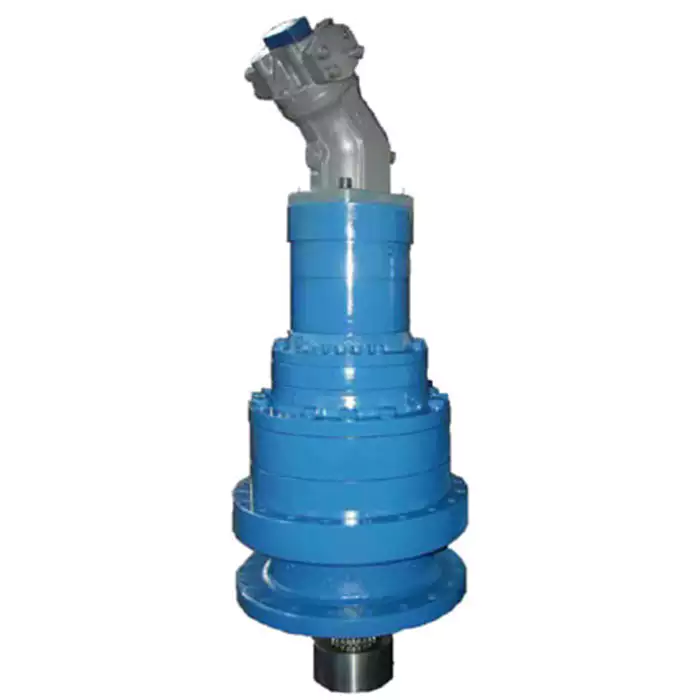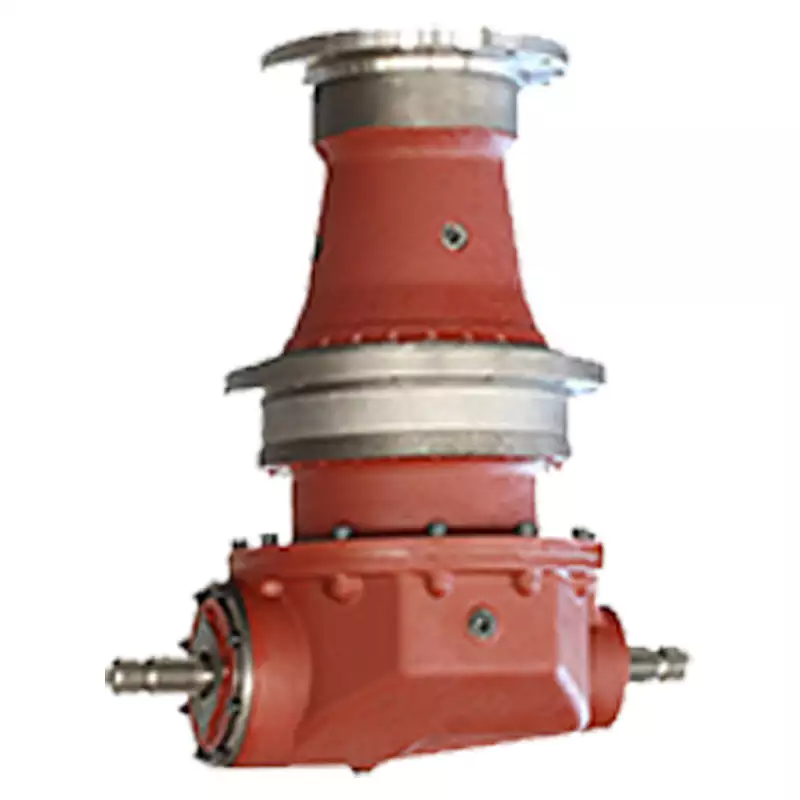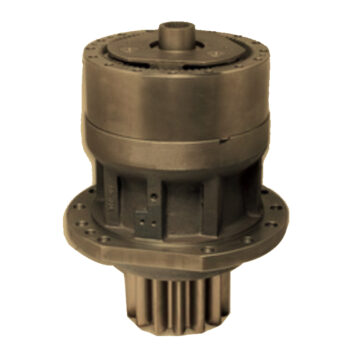Product Description
Product Features
* Compact structure, integration of alloy aluminum body to ensure the maximum rigidity and corrosion resistance, and easy to assemble with multiple precision machined surface.
* The use of top-level spiral bevel gear, with optimization design, the contact tooth surface of uniform load, allowable hith torque output.
* Gear is made of high strength alloy steel carburizing, grinding precision.
* The design of multiple alloy steel output and input shaft applies to various industrial requirements.
* The simplified structure design with high torque and low backlash applies to applications of precision servo.
* Easy mount, with maintenance-free, no need to replace the grease and long service life.
* Application in Precision Rotary Axis Drives, Travel Gantry and Columns, Material Handling Axis Drives, Industrial Areas in Automation, Aerospace, and Machine Tool and Robotics.
Product Description
Shaft Input Configuration – High Precision Spiral Bevel Gearboxes
* JAC-C Series: Shaft Input Configuration, and Hollow Output Shaft with Two Shrinks Discs.
* Models: JAC065C, JAC075C, JAC090C, JAC0110C, JAC0140C, JAC0170C, JAC210C.
* JAC-H Series: Shaft Input Configuration, and Hollow Output Shaft with Key Way.
* Models: JAC065H, JAC075H, JAC090H, JAC0110H, JAC0140H, JAC0170H, JAC210H.
* JAC-L Series: Shaft Input Configuration, and Solid Output Shaft.
* Models: JAC065L, JAC075L, JAC090L, JAC0110L, JAC0140L, JAC0170L, JAC210L.
* Gear Ratios: Spiral bevel gear set of high precision grinding can achieve from 1:1 to 6:1 as standard.
* Stage: 1 stage (1:1 to 6:1).
* Rated Output Torque (N.m): From 12N.m to 1300N.m.
* Fault Stop Torque = 2 Times of Rated Output Torque.
* Max. Input Speed (rpm): From 2500RPM to 3500RPM.
* Rated Input Speed (rpm): From 1500RPM to 2500RPM.
* Low Backlash (arcmin): From 6 arcmin to 8 arcmin.
* Max. Radial Force (N) Of Output Shaft: From 900N to 11500N.
* Max. Axial Force (N) Of Output Shaft: From 450N to 5750N.
* Max. Radial Force (N) Of Input Shaft: From 700N to 7800N.
* Max. Axial Force (N) Of Input Shaft: From 350N to 3900N.
* Low Noise Level (dB): From 71dB to 82dB.
* High Efficiency (%): 98%.
* Average Life Span (hr): 20000 hours.
* Lubrication: Synthetic lubrication grease
* Mass Moments of Inertia (kg/cm2): From 0.43 kg/cm2 to 195.4 kg/cm2.
Motor Flange Input Configuration – High Precision Spiral Bevel Gearboxes
* JAC-FC Series: Motor Flange Input Configuration, and Hollow Output Shaft with Two Shrinks Discs.
* Models: JAC065FC, JAC075FC, JAC090FC, JAC0110FC, JAC0140FC, JAC0170FC, JAC210FC.
* JAC-FH Series: Motor Flange Input Configuration, and Hollow Output Shaft with Key Way.
* Models: JAC065FH, JAC075FH, JAC090FH, JAC0110FH, JAC0140FH, JAC0170FH, JAC210FH.
* JAC-FL Series: Motor Flange Input Configuration, and CZPT Output Shaft.
* Models: JAC065FL, JAC075FL, JAC090FL, JAC0110FL, JAC0140FL, JAC0170FL, JAC210FL.
* Gear Ratios: Spiral bevel gear set of high precision grinding can achieve from 1:1 to 100:1 as standard, custom-made max. 400:1 ratio.
* Stage: 1 stage (1:1 to 6:1), 2 stage (8:1 to 30:1), 3 stage (32:1 to 100:1).
* Rated Output Torque (N.m): From 12N.m to 1300N.m.
* Fault Stop Torque = 2 Times of Rated Output Torque.
* Max. Input Speed (rpm): From 2000RPM to 5000RPM.
* Rated Input Speed (rpm): From 1500RPM to 2500RPM.
* Low Backlash (arcmin): From 6 arcmin to 15 arcmin.
* Max. Radial Force (N) Of Output Shaft: From 900N to 11500N.
* Max. Axial Force (N) Of Output Shaft: From 450N to 5750N.
* Low Noise Level (dB): From 71dB to 82dB.
* High Efficiency (%): From 94% to 98%.
* Average Life Span (hr): 20000 hours.
* Mass Moments of Inertia (kg/cm2): From 0.15 kg/cm2 to 195.4 kg/cm2.
Product Parameters
Shaft Input Configuration – High Precision Spiral Bevel Gearboxes
Motor Flange Input Configuration – High Precision Spiral Bevel Gearboxes
Product Dimensions
Shaft Input Configuration – High Precision Spiral Bevel Gearboxes
* JAC-C Series: Shaft Input Configuration, and Hollow Output Shaft with Two Shrinks Discs.
* Models: JAC065C, JAC075C, JAC090C, JAC0110C, JAC0140C, JAC0170C, JAC210C.
Shaft Input Configuration – High Precision Spiral Bevel Gearboxes
* JAC-H Series: Shaft Input Configuration, and Hollow Output Shaft with Key Way.
* Models: JAC065H, JAC075H, JAC090H, JAC0110H, JAC0140H, JAC0170H, JAC210H.
Shaft Input Configuration – High Precision Spiral Bevel Gearboxes
* JAC-L Series: Shaft Input Configuration, and Solid Output Shaft.
* Models: JAC065L, JAC075L, JAC090L, JAC0110L, JAC0140L, JAC0170L, JAC210L.
Motor Flange Input Configuration – High Precision Spiral Bevel Gearboxes
* JAC-FC Series: Motor Flange Input Configuration, and Hollow Output Shaft with Two Shrinks Discs.
* Models: JAC065FC, JAC075FC, JAC090FC, JAC0110FC, JAC0140FC, JAC0170FC, JAC210FC.
Motor Flange Input Configuration – High Precision Spiral Bevel Gearboxes
* JAC-FH Series: Motor Flange Input Configuration, and Hollow Output Shaft with Key Way.
* Models: JAC065FH, JAC075FH, JAC090FH, JAC0110FH, JAC0140FH, JAC0170FH, JAC210FH.
Motor Flange Input Configuration – High Precision Spiral Bevel Gearboxes
* JAC-FL Series: Motor Flange Input Configuration, and CZPT Output Shaft.
* Models: JAC065FL, JAC075FL, JAC090FL, JAC0110FL, JAC0140FL, JAC0170FL, JAC210FL.
| Application: | Motor, Electric Cars, Motorcycle, Machinery, Marine, Toy, Agricultural Machinery, Car |
|---|---|
| Function: | Distribution Power, Clutch, Change Drive Torque, Change Drive Direction, Speed Changing, Speed Reduction, Speed Increase |
| Layout: | Right-Angle, 90 Degree |
| Hardness: | Hardened Tooth Surface |
| Installation: | Horizontal Type |
| Step: | 1-Stage, 2-Stage, 3-Stage |
| Customization: |
Available
| Customized Request |
|---|

Challenges in Achieving High Gear Ratios with Compactness in Planetary Gearboxes
Designing planetary gearboxes with high gear ratios while maintaining a compact form factor poses several challenges due to the intricate arrangement of gears and the need to balance various factors:
Space Constraints: Increasing the gear ratio typically requires adding more planetary stages, resulting in additional gears and components. However, limited available space can make it challenging to fit these additional components without compromising the compactness of the gearbox.
Efficiency: As the number of planetary stages increases to achieve higher gear ratios, there can be a trade-off in terms of efficiency. Additional gear meshings and friction losses can lead to decreased overall efficiency, impacting the gearbox’s performance.
Load Distribution: The distribution of loads across multiple stages becomes critical when designing high gear ratio planetary gearboxes. Proper load distribution ensures that each stage shares the load proportionally, preventing premature wear and ensuring reliable operation.
Bearing Arrangement: Accommodating multiple stages of planetary gears requires an effective bearing arrangement to support the rotating components. Improper bearing selection or arrangement can lead to increased friction, reduced efficiency, and potential failures.
Manufacturing Tolerances: Achieving high gear ratios demands tight manufacturing tolerances to ensure accurate gear tooth profiles and precise gear meshing. Any deviations can result in noise, vibration, and reduced performance.
Lubrication: Adequate lubrication becomes crucial in maintaining smooth operation and reducing friction as gear ratios increase. However, proper lubrication distribution across multiple stages can be challenging, impacting efficiency and longevity.
Noise and Vibration: The complexity of high gear ratio planetary gearboxes can lead to increased noise and vibration levels due to the higher number of gear meshing interactions. Managing noise and vibration becomes essential for ensuring acceptable performance and user comfort.
To address these challenges, engineers employ advanced design techniques, high-precision manufacturing processes, specialized materials, innovative bearing arrangements, and optimized lubrication strategies. Achieving the right balance between high gear ratios and compactness involves careful consideration of these factors to ensure the gearbox’s reliability, efficiency, and performance.

Considerations for Selecting Size and Gear Materials in Planetary Gearboxes
Choosing the appropriate size and gear materials for a planetary gearbox is crucial for optimal performance and reliability. Here are the key considerations:
1. Load and Torque Requirements: Evaluate the anticipated load and torque that the gearbox will experience in the application. Select a gearbox size that can handle the maximum load without exceeding its capacity, ensuring reliable and durable operation.
2. Gear Ratio: Determine the required gear ratio to achieve the desired output speed and torque. Different gear ratios are achieved by varying the number of teeth on the gears. Select a gearbox with a suitable gear ratio for your application’s requirements.
3. Efficiency: Consider the efficiency of the gearbox, which is influenced by factors such as gear meshing, bearing losses, and lubrication. A higher efficiency gearbox minimizes energy losses and improves overall system performance.
4. Space Constraints: Evaluate the available space for installing the gearbox. Planetary gearboxes offer compact designs, but it’s essential to ensure that the selected size fits within the available area, especially in applications with limited space.
5. Material Selection: Choose suitable gear materials based on factors like load, speed, and operating conditions. High-quality materials, such as hardened steel or specialized alloys, enhance gear strength, durability, and resistance to wear and fatigue.
6. Lubrication: Proper lubrication is critical for reducing friction and wear in the gearbox. Consider the lubrication requirements of the selected gear materials and ensure the gearbox is designed for efficient lubricant distribution and maintenance.
7. Environmental Conditions: Assess the environmental conditions in which the gearbox will operate. Factors such as temperature, humidity, and exposure to contaminants can impact gear material performance. Choose materials that can withstand the operating environment.
8. Noise and Vibration: Gear material selection can influence noise and vibration levels. Some materials are more adept at dampening vibrations and reducing noise, which is essential for applications where quiet operation is crucial.
9. Cost: Consider the budget for the gearbox and balance the cost of materials, manufacturing, and performance requirements. While high-quality materials may increase initial costs, they can lead to longer gearbox lifespan and reduced maintenance expenses.
10. Manufacturer’s Recommendations: Consult with gearbox manufacturers or experts for guidance on selecting the appropriate size and gear materials. They can provide insights based on their experience and knowledge of various applications.
Ultimately, the proper selection of size and gear materials is vital for achieving reliable, efficient, and long-lasting performance in planetary gearboxes. Taking into account load, gear ratio, materials, lubrication, and other factors ensures the gearbox meets the specific needs of the application.

Common Applications and Industries of Planetary Gearboxes
Planetary gearboxes are widely utilized across various industries and applications due to their unique design and performance characteristics. Some common applications and industries where planetary gearboxes are commonly used include:
- Automotive Industry: Planetary gearboxes are found in automatic transmissions, hybrid vehicle systems, and powertrains. They provide efficient torque conversion and variable gear ratios.
- Robotics: Planetary gearboxes are used in robotic joints and manipulators, providing compact and high-torque solutions for precise movement.
- Industrial Machinery: They are employed in conveyors, cranes, pumps, mixers, and various heavy-duty machinery where high torque and compact design are essential.
- Aerospace: Aerospace applications include aircraft actuation systems, landing gear mechanisms, and satellite deployment mechanisms.
- Material Handling: Planetary gearboxes are used in equipment like forklifts and pallet jacks to provide controlled movement and high lifting capabilities.
- Renewable Energy: Wind turbines use planetary gearboxes to convert low-speed, high-torque rotational motion of the blades into higher-speed rotational motion for power generation.
- Medical Devices: Planetary gearboxes find applications in medical imaging equipment, prosthetics, and surgical robots for precise and controlled motion.
- Mining and Construction: Planetary gearboxes are used in heavy equipment like excavators, loaders, and bulldozers to handle heavy loads and provide controlled movement.
- Marine Industry: They are employed in marine propulsion systems, winches, and steering mechanisms, benefiting from their compact design and high torque capabilities.
The versatility of planetary gearboxes makes them suitable for applications that require compact size, high torque density, and efficient power transmission. Their ability to handle varying torque loads, offer high gear ratios, and maintain consistent performance has led to their widespread adoption across numerous industries.


editor by CX 2023-10-17